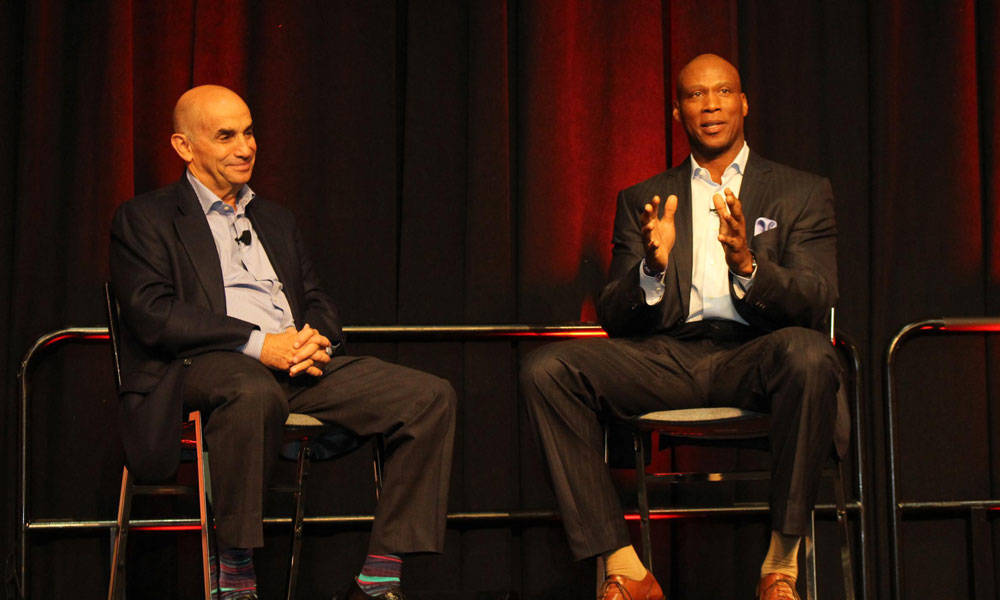
Master the Art of the Follow-Up Question
To align what you do with your members’ needs, you need to stop talking and start listening. Two sessions at ASAE’s 2018 Marketing, Membership & Communications Conference highlighted this theme, including the closing keynote from business leader Charlie Norris and NBA star Byron Scott.
Any good relationship starts with good listening. When associations listen well, they can improve the member experience and—maybe even more important—find out why some members don’t come back at renewal time.
But do you take the time to ask? And do you go deeper than a simple “Why didn’t you renew?” Asking your members follow-up questions can help you identify root causes and pain points. That’s something Charlie Norris, chairman of Freshpet, Inc., and Byron Scott, NBA basketball star and coach, encouraged attendees to do during their closing keynote address at last week’s ASAE 2018 Marketing, Membership & Communications Conference.
Their unlikely friendship was formed based on shared leadership values and a curiosity about questions, realizing that great leaders often take time to ask follow-ups. Leaders who do this are, by definition, good listeners, whether they’re in the boardroom or on the basketball court.
As coach of the Los Angeles Lakers, Scott used second and third questions to help players to reach their potential. “If there was a player struggling, I would ask: What is it that is blocking you from being great?” Scott said. “Then, my second question was: What can I do to help you improve and become a better player?” His third question was related to how that improvement might take shape.
“Byron is brilliant at asking these types of questions,” Norris said in an interview. “That’s what attracted me to him. He’s a people person, and the people he talks to can tell that he’s really listening.”
Others might say the same thing about Norris himself. In a past role as vice president of the McKesson Water Corporation, he made it a point to listen to his approximately 2,100 employees who interacted with customers at every point of sale or service. “Your frontline people need to be close to you if you want to understand what it is that customers want. Otherwise, you’re not going to win,” he said.
As a result of active listening, Norris changed McKesson’s organizational culture, empowering sales and customer service managers and encouraging senior leaders to go on ride-along visits to client sites or drop into call centers once every three months. That helped McKesson to spot pain points in the customer lifecycle.
Meet Members Where They Are
Think of how powerful such a simple strategy can be for a membership organization. The National Association of Home Builders, for example, used it to spot members’ pain points when joining or renewing.
NAHB has more than 700 components that operate on a federated model: Each chapter is an independent association with its own membership experience. That means there are hundreds of different ways for members to join, pay dues, and renew, all of which can be difficult to navigate. At one local chapter, it took 60 days for a membership application to be reviewed, approved, and processed.
“When was the last time you waited 60 days for anything?” William “Rusty” Deiss, NAHB’s assistant vice president of membership development and support, asked MMCC attendees in a session on membership impediments. After listening to members and chapter staff, NAHB began offering new choices that meet people where they are.
“We asked affiliates and our members what they really wanted,” Deiss said. “And we looked to level the playing field by offering a wide array of options.”
The NAHB team held a series of one-on-one conversations with chapters, deployed member surveys, and then sent follow-ups questionnaires asking those second and third questions to determine what offerings would be needed to ease the join and renewal processes. They concluded NAHB should add
- an option to join, renew, and pay dues online
- dues payment by credit card or ACH
- the option to pay dues annually or in installments (monthly or quarterly)
- the ability to self-manage member profile information online
- ways for members to access benefits in real time.
“We went out of our way to find several ways to automate membership,” Deiss said. “We were also looking for ways to help our local chapters save time because doing paperwork was time-consuming and complicated. We would rather free up that time so they have the ability to concentrate on the full-member experience.”
Both member engagement and renewal rates are up at NAHB. And while no change ever comes easy, listening to members and making them feel included helped the organization to succeed.
What types of second or third questions do you ask members? Has it led to any structural or organizational changes? Post your comments in the thread below.
Freshpet Chairman Charlie Norris, left, with former NBA star and Byron Scott. (Sabrina Kidwai, APR, CAE)






Comments